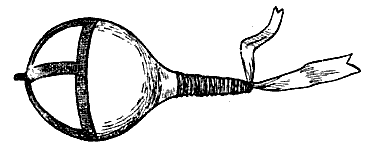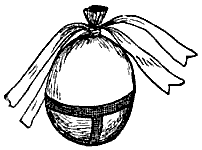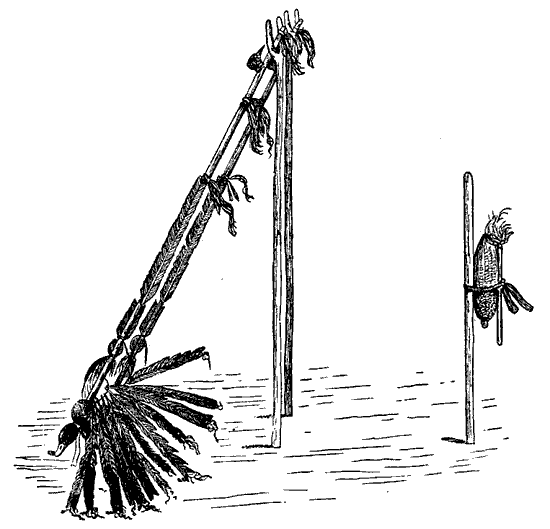| < DOMESTIC LIFE | Main Contents | INDUSTRIAL OCCUPATIONS > |
Page 276
CHAPTER VI.
VISITING CUSTOMS.
§ 116. Medicines or fetiches taken along.—Some of the C̸egiha used to take their respective medicines with them, saying, "Our medicines are wise; they can talk like men, and they tell us how many horses we are to receive from the people to whom we are going." For an account of the dance of discovering the enemy, as Dougherty terms it, see § 271. It is danced by visitors.
§ 117. Mode of approaching a village.—When people go to make a friendly visit to another tribe, they stop when they are a short distance from the village or camp of their hosts, say at about 100 or 200 yards from it. There they sit on the ground and wait for some one to come and invite them to the village. Generally, each visitor departs with his special friend, or with the messenger sent from the village by that friend. On some occasions, all the visitors have been invited to one lodge, but these have been very unusual. The Omahas, Ponkas, Dakotas, Pawnees, and other tribes act thus when they visit.
THE CALUMET DANCE.
§ 118. The Calumet Dance.—The generic term is "wáwaⁿ," in C̸egiha, answering to the  ɔiwere "wayaⁿ'we" (the specific of which is "ákiwaⁿ,"
ɔiwere "wayaⁿ'we" (the specific of which is "ákiwaⁿ,"  ɔiwere, akíyaⁿwe), to dance the calumet dance for any particular person. But the word makes no reference to dancing or singing. It is equivalent to "waqúbe ékic̷ĕ," to make a sacred kinship. He who wishes to confer this degree is called "wáwaⁿ aká," the dancer of the calumet dance, which is also the title of those who assist him. He for whom the dance is made is the "áwaⁿi aká," who becomes the adopted son of the other man.
ɔiwere, akíyaⁿwe), to dance the calumet dance for any particular person. But the word makes no reference to dancing or singing. It is equivalent to "waqúbe ékic̷ĕ," to make a sacred kinship. He who wishes to confer this degree is called "wáwaⁿ aká," the dancer of the calumet dance, which is also the title of those who assist him. He for whom the dance is made is the "áwaⁿi aká," who becomes the adopted son of the other man.
§ 119. The preliminary feast.—When a man contemplates adopting another man in this dance he invites all the other chiefs to a feast, and consults them. When the person has not been selected he says to them, "Wáwamaⁿ kaⁿ'bc̷a. Iⁿwiⁿ'c̷ixi'dai-gă"—I wish to dance the calumet dance for some one; look ye around for me (and see who would be the proper object). But if he has already selected the person, he says to the chiefs, "Áwamaⁿ kaⁿ'bc̷a. Iⁿc̷iⁿ'waⁿdaⁿ'bai-gă"—I wish to dance for him. See for me if he is the proper one. Sometimes they reply, "Let him alone! He is not the right one, as he is bad;" or, "Ni'aciⁿ-ga c̷in píadiaeresisjĭ hă. Jin'adiaeresisjĭ. Akiwaⁿ'jĭ-gă"—The man is bad. He is proud. Do not dance for him. But should the chiefs give their approval, the man sends a messenger to the one whom he intends to honor, having intrusted to him a buffalo bladder containing tobacco, which is sent as a present. When the messenger reaches the place, and delivers his message, the awaⁿi aka calls his kindred together to lay the proposi-
![]()
Page 277
tion before them. Sometimes he says, "I am poor. Do not come." In that case, the messenger returns home, and the dance does not take place. But if the awaⁿi aka approve, and his kindred give their consent, he sends the messenger back with a favorable reply. In some instances, when one man has asked another to dance the calumet dance for him, the other one has replied, "Why should I dance it for you? Why should I give such a privilege to a bad man?"
§ 120. At the appointed time, the dancing party, which consists of two leaders and many companions, repairs to the place of destination. Sometimes the leaders take from twenty to thirty men with them. They reach the lodge of the awaⁿi aka, and there the two niniba weawaⁿ, or calumet pipes, are placed on a forked support, which is driven into the soil in the back part of the lodge.
§ 121. Description of the pipes, etc.—The following is a description of the calumet pipes: In the place of a pipe-bowl each weawan has the head and neck of a "miⁿ'xa dáhiⁿ-ʇú," or green-necked duck. Next to this, on the upper side of the stem, are (yellowish) feathers of the great owl, extending about six inches. Next are long wing-feathers of the war eagle, split and stuck on longitudinally in three places, as on an arrow shaft. At the end of these is some horsehair, which has been reddened. It is wrapped around the stem, tied on with sinew, and then over that is fastened some of the fur of the white rabbit, with some ends dangling about six inches. The horsehair extends fully six inches below the fur of the rabbit. This horsehair is attached in two other places, and tied in a similar manner. The three tufts are equidistant, say six inches apart. Near the last tuft is the head of a wajiñ'ga-da, woodcock (?), the nose of which is white, and the head feathers are red. The bill is turned towards the mouth-piece.9
The head of the duck is secured to the stem by the "ha-jíde," which used to be made of deer or antelope skin, but since the coming of
Back to reference
![]()
Page 278
the white men a piece of red blanket or Indian cloth has been substituted. Next to this are suspended the two "wéʇa" or eggs, which are two hiⁿqpé, or plumes of the eagle. But the Indians compare them to the egg or to the eaglet in the egg, to which the adopted child is also likened. The child is still immature; but by and by he will grow, and fly like the eagle. Next are attached a number of eagle feathers. These are secured by two cords, called the "mácaⁿ ic̷áze c̷aⁿ," made of deer or antelope skin.
On one pipe the eagle feathers are white, being those of a male eagle, and the pipe-stem is dark blue. On the other, they are spotted black and white, being those of a female eagle; and the pipe-stem is dark blue.
§ 122. There are two gourd rattles, one for each pipe. Each gourd is about five inches in diameter. A handle is thrust through the gourd, one end of which projects about an inch beyond the top of the gourd. Blue stripes about half an inch wide encircle each gourd; and two blue stripes crossing each other at right angles extend half way around, terminating when they meet the other stripe, which divides the gourd in two parts. Around the handle is tied deer skin, antelope skin, or a piece of buffalo skin. The ʇe-néxe, or buffalo bladder, which is sent at first by the messenger, is painted with three blue stripes, as on the gourd rattles. It is tied with a small, fine piece of the skin of a deer or antelope, arranged so as to be opened very easily and with the ends dangling a little.10
§ 123. When the pipes are rested against the forked stick, the heads of the ducks are placed next the ground. A short distance from the pipes are two sticks connected with an ear of corn, which is sacred. It must be a perfect ear; the grains must not be rough or shriveled. If grains are wanting on one row or side, the ear is rejected. All the people eat the corn, so it is regarded as a mother. (See § 163.)
These sticks are reddened with wase-jide-nika, or Indian red. The longer stick, which is nearer the pipes, is stuck about four inches into the ground, and projects a few inches above the ear of corn. The other stick is fastened to the opposite side of the ear of corn; the top of it is on a line with the top of the ear, and the bottom extends a short distance below the bottom of the ear, but it does not reach to the ground. The ear of corn is held between the sticks by "ʇahá-
Back to reference
![]()
Page 279
c̷isaⁿ'," which is wrapped around them all. This fastening is made of the plaited or braided hair taken from the head of a buffalo. An eagle plume (hiⁿqpe) is fastened with sinew to the top of the smaller stick. The lower part of the ear of corn is white, and the upper part is painted green.
§ 124. Feasting and singing.—The next morning before sunrise some of the visitors sing as a signal for the people to arise and assemble. Before they sing the áwaⁿi amá say to them, "Come, O fathers, sing ye." They do not sing over an hour, perhaps not quite so long. When the men begin to sing the pipes are taken from their support, and are not returned till the singing is concluded. The singing is inside the lodge, as they sit around the fire. They sing again after breakfast, a third time in the afternoon, and once more at night. This generally continues for two days, during which time the visitors are feasted. Sometimes they continue the feasts for three days.
Gifts bestowed.—The day after the feasts, which is generally the third
![]()
Page 280
day, the principal visitor gives presents to his host, who collects all of the people of his village or tribe. He addresses the chiefs, saying, "My father has brought these things to me." Then he gives the presents to the chiefs. The pile of gifts is often about four feet high. One or more of the chiefs then speak to the young men who accompany them, "These things are given to you. Do with them as you please. Give them to whom you desire to present them." Presently one young man arises and says, "I will give a horse to my father," meaning the principal visitor. He is followed by another, and so on, till all have spoken who have a desire to make presents. Some of the young men give many horses to the visitors. When the principal chief sees that enough horses have been given in equal numbers to each visitor he says, "Come, cease ye." Then the chiefs imitate the young men in giving presents to the visitors, taking care to give none of them a larger share than the rest. This exchange of presents consumes the entire day. The principal visitor has the right to distribute the horses among his party.
§ 125. The dance.—The next day two of the servants of the principal visitor are selected to do the dancing. They must be men who are "ckaⁿ' c̷ipí," i. e., skillful in imitating the movements and acts of the war eagle, its flying, etc. When it is windy a screen is set up, but when it is calm there is none. Before the dance is begun the man for whom the ceremony is made leads his son or daughter to his visitors, saying, "C̸e ác̷awaⁿ' te hă'," Please dance for this one. But the parent does not bring the child by himself; one of the dancers always goes for the child, and must carry it on his back to the lodge where the dancers are staying. When one of the men came to the house of Mr. La Flèche for his daughter Susette, she was very small and so was afraid of the man, and refused to go with him. So her mother's mother carried her part of the way, and then the man took her to the lodge. After the father has addressed the visitors the child is caused to sit with the members of the dancing party. Its face is painted red, and over that is painted in blue, the hañga ʞi'aⁿze, and a stripe down the nose.11 An eagle plume
Back to reference
![]()
Page 281
or hiⁿgpe is placed in its hair. The child receives clothing from the principal visitor, if he has it; but if has none, another member of the party gives the clothing. Then the adopting father says to the child, "We give you a sacred thing. Do not have a bad heart. We make you sacred, we set you apart. We have received this custom from Wakanda. We give you a sign, and henceforth no one can say that you are poor."
The child so adopted is called "Hañ'ga c̷iñké" during the dance. Compare the "hŭñ'ka (huŋka)" of the Dakotas.
There is no regular order of sitting. The drummer and singers sit in the middle, and the child is with them. Near them are the two dancers, who wear no clothing but breech-cloths. Both have the hañga ʞi'aⁿze painted in red on their faces. Each one holds a gourd rattle in his right hand. It contains hard seed, beads, or fine gravel. In their left hands are the calumet pipes. They dance for about an hour, imitating the actions of the war eagle, preserving at the same time a constant waving motion with the calumet, and agitating the gourds more or less vehemently, agreeably to the music.
The villagers look on, some standing, others sitting. At the close of the dance, the crier says to the people, "Come quickly with the presents which you have promised. They will go soon." Then the people bring the horses and other presents, which they bestow upon the visitors, who lose no time in departing for home. Then the child's face is cleansed of the paint, and the two calumets are given to the family to which the child belongs. The visitors generally depart before noon, say, about 10 o'clock. Sometimes they finish the ceremony in three days, in which case one day is spent in feasting, one in making presents, and part of the third day in the dance. Sometimes they spend three days in feasting, the fourth in making presents, and part of the fifth in dancing. But the usual order is two days in feasting, one in making presents, and part of the fourth in dancing.
§ 126. Adoption and privileges of the child.—This child is ever after treated as the first-born, taking the place of the real first-born, who calls him "jiⁿc̷éha," elder brother. The wáwaⁿ aká shares his property with this adopted son, giving him presents, and never refusing him anything that he may ask of him. In like manner, the real father of the child makes presents to the real son of the wawaⁿ aka, just as if he were the child's father. This ceremony is never trifled with, though it is now obsolescent. No marriage can take place between members of these families for four years. At least, La Flèche and Two Crows never heard of any persons marrying who were related by this sort of kinship. After the first generation has passed away, the next may say, "That man's father, A, made me (C) his son. I will dance for D, the child of B, my adopted brother and son of A." Or B may say to C, "My father, A, danced for you. Do you dance for me in the person of my son, D." So the kinship used to be kept up, generation after gen-
![]()
Page 282
eration, if they liked one another; but if they did not agree, it was allowed to disappear. (See Kinship, § 78.)
A child is danced for but once by the same party. Should they come again, there are no ceremonies observed but the giving of horses and goods. The children thus honored are from five to six years of age, none over ten years of age can be thus adopted.
Frank La Flèche said, "Cañge-skă danced this dance for my father, who therefore, called him 'father'; and I, too, call Cañge-skă my father. So all the Wejiⁿcte people (being my father's gens by adoption), called Cañge-skă, 'father' for four years. Then the kinship ceased. During that period it would have been unlawful for any of my family to inter-marry with the gens of Cañge-skă."
The Ponkas are not fully acquainted with the calumet dance. They use but one pipe; but the Omahas always have two pipes.
| < DOMESTIC LIFE | Main Contents | INDUSTRIAL OCCUPATIONS > |







